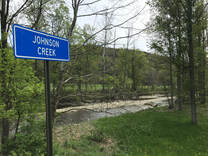CONSERVATION CORNER
A weekly blog for all things conservation
 By: Joe Quatrini, Technical Team Leader, BCCD Mud Creek, Fall Brook, Bull Run, the list of stream names goes on and on, but have you ever given any thought to how streams get their names? First off, what’s the difference between a stream, creek, brook, run, or river anyway? Well, nothing really. The terms stream, creek, brook, or run generally refer to smaller free flowing bodies of water. Many people may consider a brook or run to be smaller than a stream or creek. Whereas, the term river is used for larger bodies of flowing water, however, at their headwaters (where they start) they are often small as well. For example, here in Bradford County, we are familiar with the Susquehanna River and recognize it for its size (width, depth). Near its headwaters in Cooperstown, NY though, the Susquehanna is no bigger than many of our smaller streams. So, how did the Susquehanna and others get their names? "Susquehanna" comes from the Len'api (or Delaware Indian) term Sisa'we'hak'hanna, which means "Oyster River." (Brinton, Daniel G., C.F. Denke, and Albert Anthony. A Lenâpé – English Dictionary. Biblio Bazaar, 2009. ISBN 978-1-103-14922-3, p. 132.). Often, a stream is named based on common local names (Johnsons Creek), local features like topography or landscape (Three Fall Run), local history (Mill Creek), or even living organisms (Trout Brook). Early settlers used criteria as previously stated to name unnamed streams during exploration and westward expansion. In 1890 President Benjamin Harrison created the U.S. Board on Geographic Names (BGN) to resolve and prevent issues that may come up during geographic naming. The process for naming streams hasn’t changed much since 1890 and is still governed by the BGN. There is an online tool and a process for anyone interested in naming an unnamed stream. Visit the following site administered by the U.S Geological Survey: geonames.usgs.gov for instructions on stream naming.
Why do we care about a stream name? When a stream is unnamed, people don’t connect with it and that makes it vulnerable to water quality impacts. Trash and other pollutants are often dumped over the banks of streams with no identity. If it’s viewed as a ditch, it will be treated as such. Also, unnamed streams are viewed as unregulated and unprotected the way named streams may be. We often get calls about permitting and a landowner may state that they don’t think they need a permit because the stream doesn’t even have a name. This is certainly not the case. Any waterway with defined bed and banks is regulated the same, whether named or unnamed. Unfortunately, it is estimated that only 5% of streams are named, leaving 95% of flowing waters unnamed and viewed as insignificant and more vulnerable to degradation. In addition, many of the unnamed streams are small headwater streams. Smaller streams may be viewed as insignificant and unworthy of the naming process. This is a problem because over 70% of streams are first or second order (remember stream order from last week’s article?) and critical to the lifecycles of numerous fish, amphibians, and wildlife and important water sources for people. So, the next time you cross that small creek with no name in your neighborhood, think about some of its features or what might be living in it and come up with a name. Better yet, log in to the BGN website above and start the official naming process. The Bradford County Conservation District is committed to helping people manage resources wisely. You can visit the Bradford County Conservation District at 200 Lake Rd in Wysox across from the Wysox Fire Hall. Contact us at (570) 485-3144 or visit our web page at www.bccdpa.com.
0 Comments
Leave a Reply. |
AuthorsVarious staff at the Bradford County Conservation District Archives
July 2024
Categories
All
|
|
Bradford County Conservation District
Stoll Natural Resource Center 200 Lake Road, Suite E | Towanda PA 18848 Phone: (570)-485-3144 |
